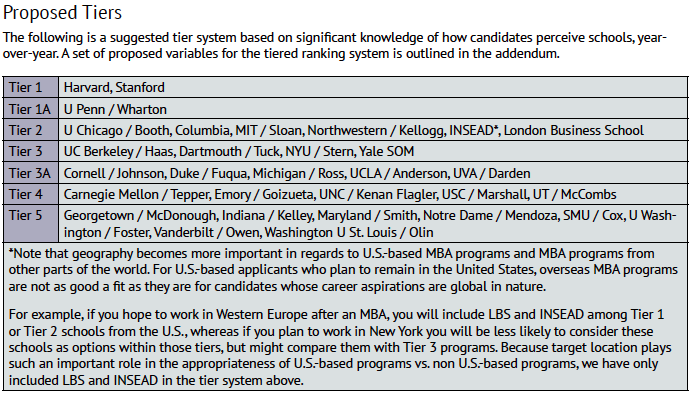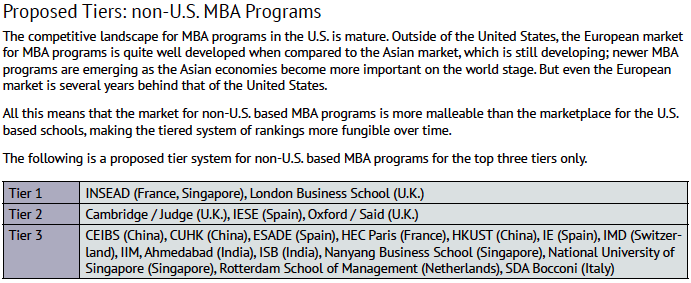As MBA hopefuls review the plethora of annual rankings, we thought it a good time to revisit another approach to MBA rankings—a tiered ranking system introduced by Clear Admit’s Alex Brown in his 2016 book Becoming a Clear Admit: The Definitive Guide to MBA Admissions.
Something of a departure from the traditional rankings produced by the Financial Times, the Wall Street Journal, U.S. News & World Report, and other publications, this novel MBA ranking system groups similarly competitive schools in the same tier. Below we’ve provided an excerpt from Brown’s book discussing explaining the tiered system, as well as author commentary. And don’t miss this article, in which we go into further detail about how Clear Admit’s MBA DecisionWire data further supports a tiered ranking system for business schools.
Book Excerpt:
To differentiate schools in terms of overall quality, a tiered system works better. By grouping similarly ranked schools together, you can then determine which tier of schools you should be targeting, and then decide which are your preferred schools within a tier, based on fit. This works better because it moves away from the idea that one school is better than another within a tier, and schools can only move from one tier to another, which is more meaningful than small movements from one place in a rank order to another (5th place to 2nd place, for example).
Moving from one tier to another will take considerable change on the part of the school, and can only really happen with a long-term view of the school, rather than short-term data manipulations to pander to a specific ranking algorithm: for example, focusing on increasing the GMAT scores of entering students to improve a ranking in U.S. News.
For application choices: You can select schools from different tiers, much like you will typically select “reach” schools, “realistic schools” and “safety schools” to ensure success in the admissions process. The tiered system makes it easier for you to determine which schools belong to which categories.
For the matriculation decision: You can choose between schools within a tier, based on your own rational reasons. Unless other issues are relevant (scholarship money, geographic constraints, family considerations), you should select a school from the highest tier to which you were admitted.
Like all rankings, this tiered system is not definitive, but by not ranking schools within a tier, schools that are very closely matched in terms of overall quality are considered equal, allowing fit to become more prominent in your ultimate matriculation decision.
The challenge to the tiered system is to take into account the size of the school. Size impacts intimacy and engagement and the breadth of resources available (i.e. classes, clubs, industries recruiting, critical mass of interest in niche events), impacting the diversity of choice, options, and classmates. How do you design a system that gives an equal voice to the smaller programs like Dartmouth/Tuck?
Author’s Commentary:
The rationale for the tiered system is that for schools that are very similar in terms of quality, it makes sense to group them together, rather than to try to rank them. Candidates can then make better choices in terms of the right schools to target by determining which tier best fits their competitiveness and then examining the schools within that tier in terms of cultural fit, geography and career opportunities (all of which are discussed in the book).
Some who read this will want to debate the tiers and, specifically, which schools belong in which tiers; that is completely fair. In my opinion, there is less room for debate around Tiers 1, 1A and 2 for U.S.‒based schools. Not coincidently, they include the “M7” schools, often cited as the very best schools by the candidates targeting them.
As you drop down the tiers, the schools included in each does become more debatable. Here’s why I included Haas, Stern, Tuck and Yale in Tier 3: Tuck is perennially considered one of the top schools and just outside the M7 group; some will argue that Tuck stands slightly above the others in that regard. Haas and Yale appear to be schools that have been improving their reputations in recent years. And Stern is able to take advantage of its proximity to Wall Street to attract many MBA candidates. Tier 3A includes schools that are reasonably close in terms of reputation to the preceding four schools. Some might group all nine schools in the same tier, or move a few around within Tiers 3 and 3A.
In grouping schools, I also found it very hard to place non U.S.‒based schools within the same tier as U.S.‒based schools. While I am convinced that INSEAD and London Business School are comparable to “M7” schools in the United States when considered in terms of their general competitiveness, the issues of geography and career focus do come into play. For a candidate whose aspirations are to work in Europe, for example, INSEAD and London Business School would most certainly be comparable to Tier 1 and 2 schools. But for a candidate hoping to work in New York City, the leading European schools would compare with Tier 3 or 4 schools in terms of the U.S. career access they can provide. This is why I developed a separate tiered ranking system for non U.S.‒based schools. A separate ranking also made sense given that the competitive nature of the marketplace is still developing, especially in Asia.
So, while some will certainly argue about which schools belong in which tiers, I think that a tiered system provides a better understanding of the competitive landscape for top MBA programs and will help candidates in their selection of the appropriate schools to target.








